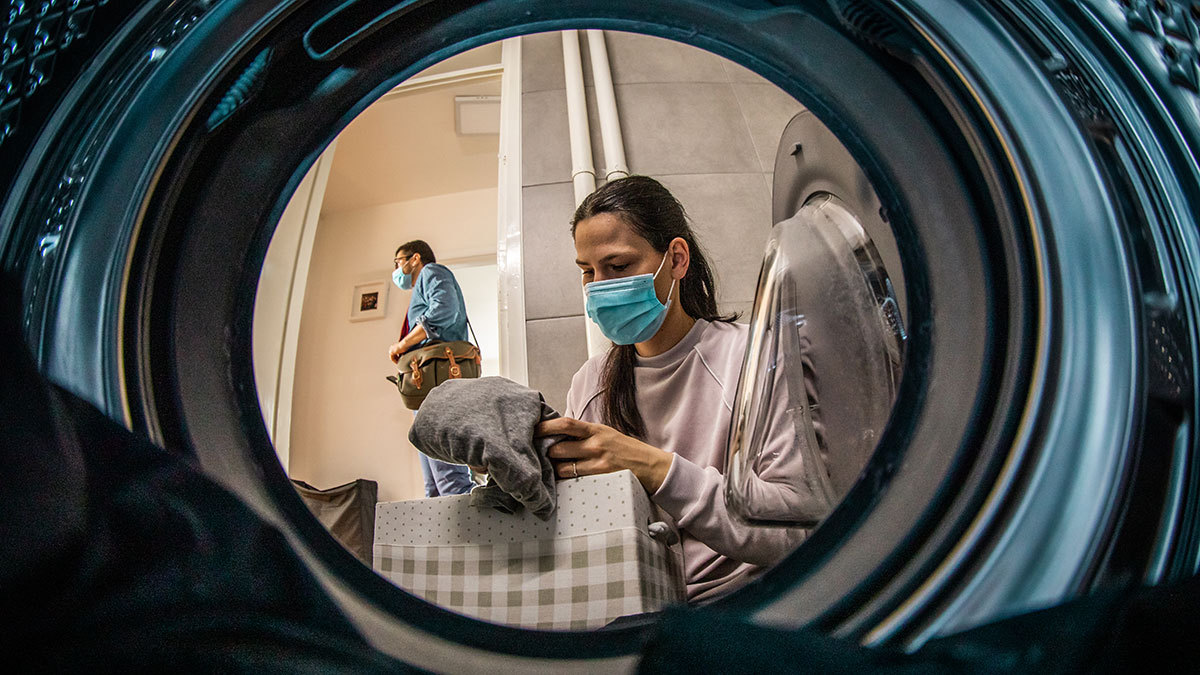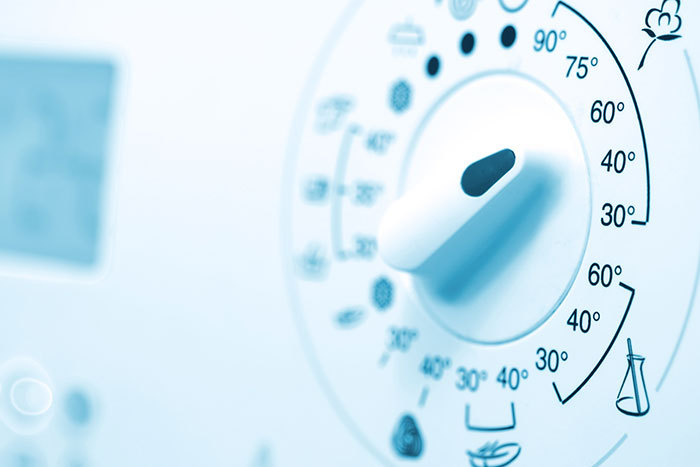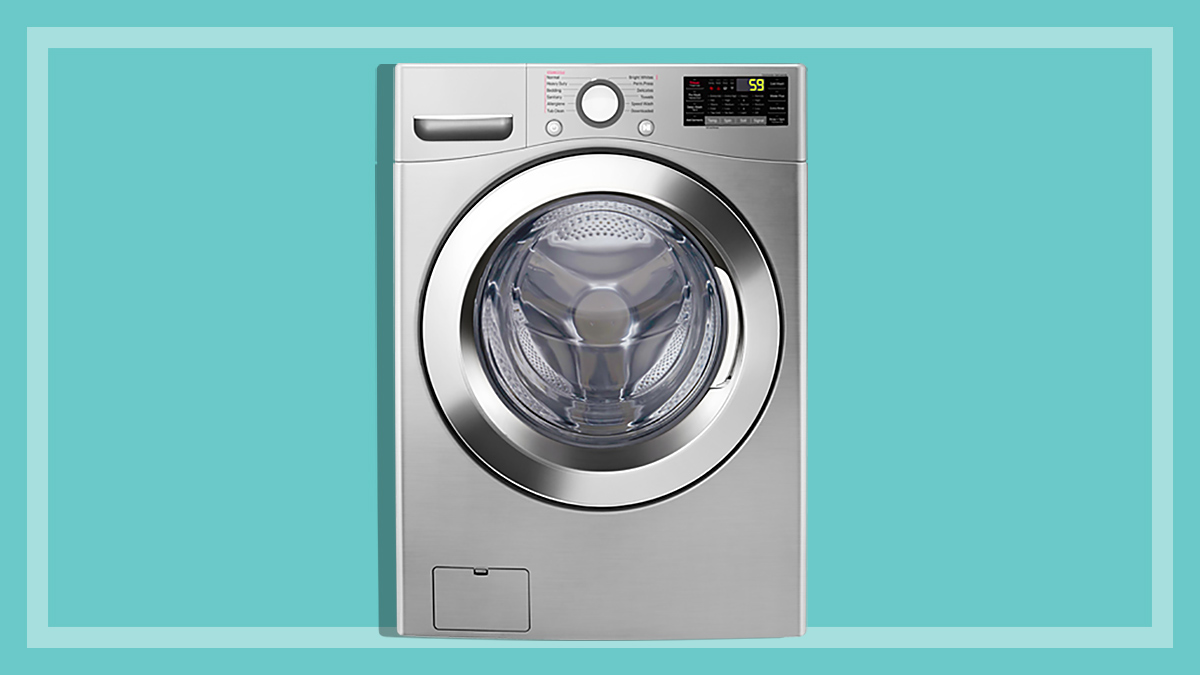Get our independent lab tests, expert reviews and honest advice.
How to do your laundry during a pandemic

Need to know
- Clothes can carry viruses, including COVID-19, but you're probably already doing everything you need to with your laundry
- There are things you can do to further minimise the risk, even when caring for someone who has caught the virus
On this page:
- Will your washing machine keep COVID-19 at bay?
- How to do your laundry to protect yourself against viruses
- Does the dryer kill viruses?
- Can UV light kill viruses?
- Does steam kill viruses?
- Can essential oils kill viruses?
- Which cleaning products kill viruses?
- How do you wash a face mask?
- Do you need to decontaminate your washing machine?
Many germs, including the coronavirus that causes COVID-19, can be transmitted via contaminated clothing and towels.
With COVID-19 still active in the community, it pays to take a few precautions. The good news is, unless you’re caring for someone who’s infected or in a high-risk category, those precautions aren’t too onerous.
Will your washing machine keep COVID-19 at bay?
If you’re dealing with lightly soiled items that you consider low risk (i.e. haven’t come into contact with a known infection), then your current washing machine and normal laundry detergent are excellent tools in the fight against transmission.
The combination of detergent, hot water, agitation, rinsing and spinning that’s part and parcel of your existing laundry routine is very effective at rendering inactive, removing and flushing away viral loads.
According to the National Health Service (NHS) in the UK, where they’ve dealt with many more cases of COVID-19 than we did in Australia, “normal washing of clothes will reduce the risk of germs being transmitted”.
Even if you have extra reason to be concerned – for example, you may have come into contact with the virus – you don’t have to change your laundry routine much to stay safe. According to the NHS, “in certain situations clothes should be washed at higher than normal temperatures and with a bleach-based product to minimise the transmission risk as much as possible.”
How to do your laundry to protect yourself against viruses
Here’s how to wash your clothes and other items to help reduce the risk of exposure to harmful viruses such as COVID-19.
Wash on the hottest program your care label recommends
While we normally recommend washing in cold water, heat is one of the best ways of rendering viruses inactive. If you’re washing by hand, make it as hot as you can stand.
Wash high-risk clothes at 60°C or above

Clothing that’s been exposed to bodily fluids – such as blood, vomit, sweat and faeces, including clothing worn over an open wound and communal towels – can spread viruses readily. This means you should wash your workout gear, towels, underwear and especially reusable nappies and baby clothes at 60°C or hotter.
Heavily soiled items and clothing used in food preparation should be washed separately, and don’t re-wear your smelly gym clothes – put them straight in the wash, even if you exercise alone.
Don’t share towels
Sharing towels is a hygiene horror story, and one of the easiest ways to spread germs from person to person. And this includes hand towels too – even if you’ve just washed your hands for the requisite 20 seconds.
Dry laundry thoroughly after washing
Viruses spread more easily via wet surfaces than dry ones, so make sure your laundry’s completely dry after washing to minimise the risk of contamination.
Does the dryer kill viruses?
Not necessarily, but it may, depending on how hot it can get. And while we usually advocate line drying if possible, this is one time where deferring to the dryer might be of benefit. Despite sunlight’s mild germ-killing properties, the hot air in your dryer will do a much better job at rendering viruses inactive.
Can UV light kill viruses?
Yes it can, though there are several different types of UV light with varying effectiveness. UVC is the most effective at stopping viruses, and it’s used in some healthcare settings to disinfect surfaces and equipment. It can also be used to kill off harmful bacteria in drinking water, and UV sterilisers are a handy tool for travellers and hikers.
Sunlight also contains UV light, although it’s mostly UVA and UVB. These types of UV light are less effective at rendering viruses inactive, though they can definitely give you a nasty sunburn. So while sunlight – aka line drying – has a mild antiviral and antibacterial effect, you can’t rely on it to destroy viruses such as COVID-19 on your clothes, or in you.
Does steam kill viruses?
Under certain circumstances, yes, and steam is used to destroy viruses in autoclaves. However, the steam in autoclaves is used in a controlled setting under pressure and at high temperatures, and it’s unclear if steam from a washing machine with a steam function would be effective against viruses on soft materials like clothes.
So while it certainly wouldn’t hurt to use the steam or sanitise setting if your washing machine has one, the advice from experts including the Centers for Disease Control and Prevention (CDC) in the US remains that washing in hot water is the most effective way to deal with COVID-19 in the laundry.
Can essential oils kill viruses?
While there is some evidence to suggest some essential oils are effective in breaking down some ‘enveloped’ viruses such as influenza, research is extremely limited. While Sars-CoV-19 is also an enveloped virus there is currently no evidence to suggest essential oils have any effect on it, and they’re not recommended in its treatment or prevention.
Which cleaning products kill viruses?
Laundry detergent
Like soap, your typical laundry detergent does a great job of breaking down and destroying viruses. For regular day-to-day washing, your normal detergent in a warm wash should be perfectly sufficient to destroy any on your clothes.
If you’ve come into direct contact with a virus, or are in a high-risk environment, you should also endeavour to wash in the hottest water your clothes and your washing machine can manage (the current understanding is that temperatures over 60°C are sufficient to render viruses such as the one that causes COVID-19 inactive), and consider using an oxygenated bleach, or switching to a bleach-containing detergent.
Bleach
Bleach is one of the best household cleaners to use with any virus, and laundry-specific oxygenated bleach is a powerful antiviral tool in the laundry, particularly for clothing that may have come into contact with the virus.
Follow the dilution instructions on the bottle and not only will bleach help keep your whites their whitest, but according to the International Scientific Forum on Home Hygiene, it may help render viruses inactive in the wash. Many laundry detergents already contain colour-safe bleaching agents, so check the box or bottle in your laundry, and if yours doesn’t, consider switching to one that does.
Like bleach, hydrogen peroxide is also a powerful disinfectant, and will do a good job of sterilising surfaces but may not be suitable for use on clothing.
Safety warning: Do not use chlorine bleach in your washing machine (it can damage and discolour fabrics) and never mix bleach with vinegar or other cleaning products as this can create toxic gas.
Alcohol
Ethanol in concentrations greater than 65% will effectively render most coronaviruses inactive. While ethanol has limited uses in the laundry, it’s the basis for most hand sanitisers which, in the absence of soap, are recommended for keeping your hands virus free.
Does vinegar kill viruses or bacteria?
Vinegar is a popular, cheap and natural surface cleaner. White distilled vinegar contains 5% acetic acid, a compound that can dissolve dirt, debris and grime, but it only has limited effectiveness as a disinfectant. It can’t kill all germs, and this includes the virus that causes COVID-19.
How do you wash a face mask?
If you wear a face mask (or gloves for that matter), then you should change it often. Face masks can quickly build up large viral loads as they have warm, moist air (your breath) constantly moving through them. Think of wearing a contaminated mask as the same as holding a damp cloth soaked in germs to your mouth and nose and you’ll see why it’s a problem.
Fabric masks should be washed in hot water, and dried thoroughly before you wear them again. Disposable masks are strictly single use, so throw them away (responsibly) after use.
Extra precautions for someone with COVID-19
Doing the laundry safely is particularly important if someone in your household might have the virus (confirmed or suspected), is in a high-risk category (such as those with a compromised immune system), or is a frontline care worker who is likely to come into contact with the virus.
The above washing practices are effective in rendering contaminated clothing safe (and you should consider all clothing, towels and linen used by these groups as contaminated), so it’s fine to combine contaminated clothing with your regular clothes in the machine, but there are a couple of additional precautions you should take.
Handle contaminated clothing with care
The CDC recommends wearing gloves when handling contaminated clothing, particularly if it has come into contact with bodily fluids. Dispose of gloves safely after loading the washing machine (the CDC has an excellent guide on how to remove gloves safely).
Whether you’re wearing gloves or not, be mindful of keeping your hands away from your face during the entire process, and wash your hands thoroughly with soap and water for at least 20 seconds afterwards.
Wash hot and with bleach
Wash contaminated clothing in hot water – ideally 60°C or above (provided it won’t damage the fabric) – and use a bleach-containing detergent, or if washing whites, then add bleach to the wash itself (following the manufacturer’s recommendation) for the best virus-destroying performance.
Store contaminated laundry separately
While you’re fine to wash contaminated clothing together with other items (unless it’s heavily soiled), keep it in a separate hamper until laundry day. And on the subject of laundry hampers, do use one rather than the ‘floordrobe’, so contaminated clothes are put away safely. You should use a washable or disposable liner for that hamper, and change it when you wash.
Give flicking the flick
Do not shake out contaminated laundry – it can release viruses and other germs into the air. Carry contaminated clothing carefully and load your washing machine gently.
Sanitise contact surfaces
Once the laundry’s on, clean and sanitise any surfaces you’ve had contact with in the course of doing the laundry using bleach or household disinfectant. This includes the door and control panel of your washing machine, the laundry doorknob, and of course the hamper you’ve kept contaminated clothing in (and throw the hamper liner in with the wash too, if it’s reusable).
Change clothes early and often
If you’re a frontline health worker or have likely come into contact with the virus during your day, then change clothes as soon as possible or at least as soon as you get home, and treat what you were wearing as you would other contaminated clothing. This minimises your exposure if your clothes do happen to have the virus on them.
Do you need a washing machine with a sanitise program?
For most of us, a regular wash with hot water and detergent will do a perfectly good job of getting your laundry clean and virus-free.
A sanitising washing machine is a washing machine with a special program that uses super-heated steam or water to kill off germs and bacteria in your clothes, sterilising them and leaving them smelling better.
They tend to be more expensive than regular machines and unless you’re a frontline health worker, immunocompromised, or have a bad reaction to dust mites and the like (which sanitising programs kill as well), then your current washing machine’s just fine.
Do you need to decontaminate your washing machine?
The same combination of hot water, detergent and agitation that releases viruses from your laundry and flushes them away should keep the insides of your washing machine virus-free.
While you can use bleach to sanitise the doors and controls, you shouldn’t use it undiluted inside the machine at all (other than oxygen-based bleaches as part of a wash cycle, following the manufacturer’s instructions), as it can potentially damage rubber seals and hoses.
There are several commercially made antibacterial washing machine cleaners available, many of which use an oxygen-based bleach to kill most of the microbes that may have gathered. While this might give your washing machine a good spring clean, clearing out scrud and helping it work (and probably smell) better, it’s worth noting that viruses and bacteria are two different things, so they may not help protect against COVID-19 anyway.
Can you carry viruses inside on your shoes?
Yes. Shoes can and do pick up all sorts of nasties (not just viruses), but you can consider them low risk because you typically don’t put them on the dining table or in your mouth – you’re already naturally treating them as dirty.
You can keep shoes clean the same way you clean and sanitise hard surfaces (wipes are good for this, and you can dispose of them after), but you can also kick them off outside so as not to track the virus into your home.
Can you still use dry cleaners, laundromats or shared laundry facilities?
Even in the age of social distancing, doing the laundry is a fairly low-risk activity. You’re more at risk from someone coughing near you than you are of infection from touching surfaces, so a few simple precautions are all that’s needed to protect yourself and others.
Sanitise hard surfaces
Treat communal laundry facilities the way you would if you were doing the laundry for someone who is sick at home, and sanitise hard surfaces – controls, washing machine lids and door handles – on your way in and out.
Practice social distancing
Stay 1.5 metres away from other people, and don’t linger while you’re waiting for your laundry to be done – sit outside in the fresh air or go for a walk instead.
Wash your hands on entry and exit
Use soap and water, or failing that, use hand sanitiser – just as you would when visiting any other establishment.
If you’re sick, then stay home
It should go without saying that if you’re carrying a communicable disease you shouldn’t venture to the laundromat – stay home until you’re well again. Even then, you should still wait a couple of days before doing the laundry, because viruses can survive on clothing for a little while and this will reduce the risk of turning laundromat patrons into patients.






